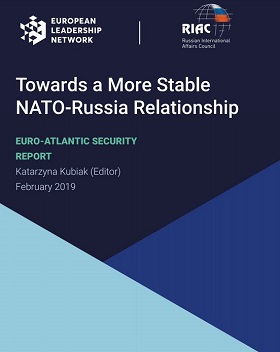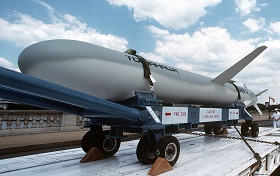The return to an outright deterrence relationship between NATO and Russia involves the danger of an arms race and a number of military risks, particularly in the NATO-Russia contact zones. These risks can be contained by means of sub-regional arms control. Approaches of this kind should comprise sub-regional force limitations, limitations of military exercises, transparency and inspection rules for rapid deployment and long-range strike capabilities outside the zone of limitations, as well as a strict verification regime. Measures should be based on existing agreements rather than negotiating a new treaty.
What unites most governments in Europe is the conviction that strengthening one’s own military capabilities is more important than cooperative security approaches. We are seeing the return of a mutual deterrence scenario coupled with the progressive erosion of cooperative security policies that were pursued until the early 2000s. To be sure: We never had a pure cooperative security scenario, but rather a hybrid mix of cooperative and deterrence elements. But even this led to an unprecedented reduction of conventional and nuclear weapons in Europe.
Currently, we are experiencing a quick reversal of this positive trend at all levels: We are witnessing the re-emergence of strong threat perceptions that are directly contrary to one another and mutually exclusive. Military exercises on both sides are approaching the levels reached in the Cold War. And we see hardening military postures, states investing more, modernizing and in some cases enlarging their armed forces. Although we have not yet reached a full arms race, we are on the brink of one. In terms of military options, the issue at stake is no longer “large-scale offensive options” of a continental-size in the sense of the preamble of the CFE Treaty, but the perception of emerging options for a surprise attack in the contact regions between NATO and Russia, particularly in the Baltic and the Black Sea regions.
Sub-regional arms control is disputed by many for three main reasons. Some are afraid of the political singularization of those who would fall under a sub-regional arms control regime contrary to others who would not. Second, some governments are afraid that sub-regional or any kind of arms control would divert attention from necessary defense measures. And finally there is concern that sub-regional arms control might not be feasible in operational terms in the sense that there is always an impact from outside into the zone covered by a sub-regional arms control regime.
The return to an outright deterrence relationship between NATO and Russia involves the danger of an arms race and a number of military risks, particularly in the NATO-Russia contact zones. These risks can be contained by means of sub-regional arms control. Approaches of this kind should comprise sub-regional force limitations, limitations of military exercises, transparency and inspection rules for rapid deployment and long-range strike capabilities outside the zone of limitations, as well as a strict verification regime. Measures should be based on existing agreements rather than negotiating a new treaty.
Currently, there is a little scholarly discussion on new initiatives or innovative approaches to conventional arms control (CAC) in Europe. A diligent study by Peter van Ham from the Dutch Clingendael Institute — “Modernizing conventional arms control in the Euro-Atlantic region” — discusses the merits of different approaches. A very critical report by the Swedish FOI Institute — “Conventional Arms Control. A Way Forward or Wishful Thinking?” — , edited by Johan Engvall and Gudrun Persson, focuses more on the question as to why German Social Democrats, in the wake of the 2016 Steinmeier initiative, are focusing so much on CAC than on the issue itself. And finally, in the framework of the OSCE Network of Think Tanks and Academic Institutions, a group of authors from Germany, Latvia, Poland, Russia, Switzerland, Turkey, and the US presented a concrete proposal for sub-regional arms control in the Baltic region — “Reducing the Risks of Conventional Deterrence. Arms Control in the NATO-Russia Contact Zones”.
There are many, to some extent, reasonable arguments questioning new efforts for CAC. The Conventional Armed Forces in Europe (CFE) Treaty is politically dead, the modernization of the Vienna Document on Confidence- and Security-Building Measures 2011 (VD11) is blocked. Why should any new initiative for CAC fly? In a broader sense, it is argued that, with the failure of the INF Treaty, the termination of the Iran nuclear agreement by the US and the uncertain future of the New START Treaty arms control, in general, has become almost unachievable. There is deep mistrust on all sides. Western governments argue that there cannot be business as usual (including arms control) with Russia as long as the Russian government is backing secessionist forces in Eastern Ukraine, while the Russian side is arguing that arms control is blocked by NATO’s ambitions for military superiority.
The Return of Deterrence
What unites most governments in Europe is the conviction that strengthening one’s own military capabilities is more important than cooperative security approaches. We are seeing the return of a mutual deterrence scenario coupled with the progressive erosion of cooperative security policies that were pursued until the early 2000s. To be sure: We never had a pure cooperative security scenario, but rather a hybrid mix of cooperative and deterrence elements. But even this led to an unprecedented reduction of conventional and nuclear weapons in Europe.
Currently, we are experiencing a quick reversal of this positive trend at all levels: We are witnessing the re-emergence of strong threat perceptions that are directly contrary to one another and mutually exclusive. Military exercises on both sides are approaching the levels reached in the Cold War. And we see hardening military postures, states investing more, modernizing and in some cases enlarging their armed forces. Although we have not yet reached a full arms race, we are on the brink of one. In terms of military options, the issue at stake is no longer “large-scale offensive options” of a continental-size in the sense of the preamble of the CFE Treaty, but the perception of emerging options for a surprise attack in the contact regions between NATO and Russia, particularly in the Baltic and the Black Sea regions.
The Risks of Deterrence
Any military deterrence relationship necessarily involves risks and inherently drives escalation. The three most important drivers of escalation are uncertainty, sub-regional conflicts, and the nuclear dimension. Uncertainty and the lack of military transparency are driving the two sides into a security dilemma with inherent worst-case thinking. Sub-regional conflicts — just imagine a re-escalation of hostilities in Ukraine — can be a powerful factor in raising the level of tensions in Europe. And finally, the failure of the INF Treaty will most probably have a destabilizing impact on the deterrence relationship in Europe.
These military risks in a narrower sense are aggravated by two broader global trends: With the rise of China and other emerging powers, we are passing through a period of hegemonic change that is characterized by a maximum of uncertainty and volatility. And we are passing through the two or three and not many more decades that are critical for stopping a global climate disaster. Both lines of risk, the more narrow military one as well as the broader global dimension, make it imperative to avoid a new arms race in Europe (and elsewhere) that would spoil scarce resources and attract the political attention that we urgently need to address global problems.
Options for Conventional Arms Control in Europe
Against this background, there are basically three options of addressing risks ensuing from a deterrence scenario dominated by conventional armed forces. The first is traditional measures of risk reduction, bilateral or multilateral agreements on the avoidance of incidents and accidents, possibly augmented by transparency measures. A good example is the Baltic Sea Project Team. Measures of this kind are considered by most governments, at least in principle. They are urgently needed, but clearly insufficient in view of the present and future risks.
A second option would be a comprehensive, pan-European post-CFE agreement that also involves new military options and types of equipment. The 2016 Steinmeier initiative for reviving arms control in Europe comes closest to this option. Despite discussions in a German-led Like-Minded Group this option seems to be far too ambitious under the current conditions. It would rather fit a cooperative security policy scenario that is beyond reach at the moment.
The third option consists of using arms control instruments for stabilizing the given deterrence relationship focusing on those areas where the danger of destabilization is most imminent, that is the contact zones between NATO and Russia. This option remains within the scope of mainstream deterrence thinking. It requires an approach of sub-regional arms control.
Problems of Sub-regional Arms Control
Sub-regional arms control is disputed by many for three main reasons. Some are afraid of the political singularization of those who would fall under a sub-regional arms control regime contrary to others who would not. Second, some governments are afraid that sub-regional or any kind of arms control would divert attention from necessary defense measures. And finally there is concern that sub-regional arms control might not be feasible in operational terms in the sense that there is always an impact from outside into the zone covered by a sub-regional arms control regime.
However, sub-regional approaches have been considered time and again. The negotiations on Mutual Balanced Force Reductions (MBFR, 1973-1989), the predecessor negotiations of the CFE talks, dealt solely with sub-regional approaches. And Chapter X of the VD11 explicitly addresses “Regional Measures.” If the three arguments quoted above are taken seriously, it is possible to establish valid sub-regional arms control regimes. The three key factors are an arms control zone large enough to dispel singularization fears and to limit properly the sides’ forces in an equal manner; sufficient regulations for armed forces outside the zone; and a thorough transparency and verification regime.
A Model for Sub-regional Arms Control in Europe
The authors of the Risk Study elaborated a model for sub-regional arms control taking the Baltic Contact Zone as an example. This zone would comprise Estonia, Latvia, Lithuania, Poland, the Eastern part of Germany covered by the 2 plus 4 Treaty, Belarus, and parts of the Western Military District of Russia. The zone is large enough to dispel fears of singularization as it covers parts of Germany and Russia. And it is also large enough to cover a substantial part of the sides’ forces. The Baltic arms control regime would be equipped with the following main features:
- No permanent deployment of additional substantial combat forces would be allowed in the Baltic Contact Zone. This builds on the obligation of NATO in the 1997 NATO-Russia Founding Act to avoid “additional permanent stationing of substantial combat forces” in the newly admitted NATO states and the corresponding obligation of Russia in the 1999 CFE Final Act not “to station substantial additional combat forces” in the Kaliningrad and Pskov oblasts. Although there is no shared definition of the term “substantial combat forces,” there is wide-shared agreement that these two obligations are still valid and have not been broken. To make them operational for a sub-regional arms control regime, it would only be necessary to agree on a definition of “substantial combat forces” and to recommit to these obligations. The commitment not to increase combat forces in the contact zone would represent the key element of the sub-regional arms control regime.
- In addition, military exercises in the contact zone would be limited in size, frequency, duration and geographical proximity to borders. Such an agreement could be regarded as a measure under Chapter X of the VD11.
- As a complementary measure, rapid deployment and long-range strike capabilities deployed beyond the contact zone should be subject to a notification and observation regime.
- All measures agreed would be subject to sufficiently strict transparency and verification regime that could also be established in the frame of the VD11. Certainly, additional quota for inspections and evaluation visits would become necessary.
Is Sub-regional Arms Control in Europe Possible?
Such a regime would have two important advantages: It would address the real risks, namely sub-regional offensive options, and it would build on the adaptation of existing agreements, the VD11, the NATO-Russia Founding Act and the CFE Final Act, rather than negotiating a completely new treaty. A sub-regional arms control regime of this kind is modest in the sense that it remains within the framework of a mutual deterrence relationship. However, it is bold in that it would introduce effective steps for stabilizing this relationship.
Is such an approach to conventional arms control in Europe feasible under the current conditions? Certainly not, if we continue to exchange almost ritualized mutual accusations. And it will become possible only when we recognize that extraordinary circumstances require special measures.
It will certainly not be possible if talks on conventional arms control are conducted predominantly at expert levels. These issues must be dealt with at the higher political levels, including heads of state and government, and ideally embedded in a broader approach of pragmatic cooperation.








